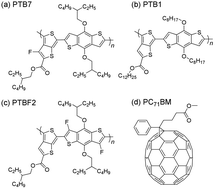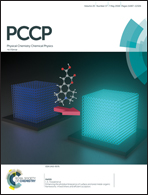Investigations on the charge transfer mechanism at donor/acceptor interfaces in the quest for descriptors of organic solar cell performance†
Abstract
Herein, we theoretically and experimentally investigated the mechanisms of charge separation processes of organic thin-film solar cells. PTB7, PTB1, and PTBF2 have been chosen as donors and PC71BM has been chosen as an acceptor considering that effective charge generation depends on the difference between the material combinations. Experimental results of transient absorption spectroscopy show that the hot process is a key step for determining external quantum efficiency (EQE) in these systems. From the quantum chemistry calculations, it has been found that EQE tends to increase as the transferred charge, charge transfer distance, and variation of dipole moments between the ground and excited states of the donor/acceptor complexes increase; this indicates that these physical quantities are a good descriptor to assess the donor–acceptor charge transfer quality contributing to the solar cell performance. We propose that designing donor/acceptor interfaces with large values of charge transfer distance and variation of dipole moments of the donor/acceptor complexes is a prerequisite for developing high-efficiency polymer/PCBM solar cells.



 Please wait while we load your content...
Please wait while we load your content...
